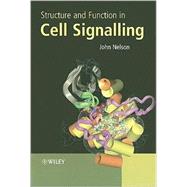
Note: Supplemental materials are not guaranteed with Rental or Used book purchases.
Purchase Benefits
What is included with this book?
John Nelson, Queen's University, Belfast, UK.
| Acknowledgments | |
| Preface | |
| The components and foundations of signalling | |
| Definition of terms used | |
| Historical foundations | |
| Early milestones in signal transduction research | |
| The discovery of receptors and G proteins | |
| cAMP pathways | |
| cAMP: ancient hunger signal - primitive signalling in amoebazoans and prokaryotes | |
| References | |
| Enzymes and receptors - quantitative aspects | |
| Enzyme steady state assays - Michaelian enzymes | |
| Receptor equilibrium binding assays | |
| The receptor's environment | |
| Guanine nucleotides and the agonist 'affinity-shift' of 7-pass receptors | |
| References | |
| Modules and motifs in transduction | |
| Src homology domains | |
| PH superfold modules: PH-, PTB- and PDZ-domains | |
| Bcr-homology (BcrH) domains | |
| Dbl homology (DH) domains - partners of PH domains | |
| Bcl-2 homology (BH) domains | |
| Ras binding domains | |
| Phosphoserine/phosphothreonine-binding domains | |
| EF-hands - calcium-sensing modules | |
| C1 and C2 domains - a Ca2þ-activated, lipid-binding, module | |
| References | |
| Protein kinase enzymes - activation and auto-inhibition | |
| The protein kinase fold | |
| Protein kinases activated by A-loop phosphorylation | |
| The insulin receptor kinase (IRK) - a 'gated' kinase | |
| Cyclin dependent kinases | |
| Secondary inhibition mechanisms - PKA | |
| References | |
| 7-pass receptors and the catabolic response | |
| 7-pass receptor phylogeny | |
| Functional mechanisms of 7-pass receptors | |
| Amplification | |
| Adenylyl cyclase - signal limitation | |
| Adenylyl cyclase isoforms | |
| G proteins and the adenylyl cyclase effector isoforms | |
| Regulatory subunits of PKA and A-Kinase Anchoring Proteins | |
| Phosphorylase kinase | |
| Glycogen phosphorylase | |
| Glycogen synthase | |
| Remaining questions - scaffolds and alternate second messenger 'receptors' | |
| G protein coupled receptor kinases - downregulators, signal integrators | |
| References | |
| Single pass growth factor receptors | |
| Receptor tyrosine kinases - ligands and signal transduction | |
| The PDGFR family - signal transduction | |
| PDGFR family autoinhibition: juxtamembrane and A-loop tyrosines | |
| Crystal structure of kinase domain of PDGFR family-A member: Flt-3 | |
| The ErbB family | |
| ErbB-type receptor signal transduction particles | |
| Autoinhibition of EGFR and activation | |
| References | |
| G proteins (I) - monomeric G proteins | |
| Classification | |
| ON and OFF states of Ras-like proteins | |
| Raf - a multi-domain serine/threonine kinase family of Ras effectors | |
| Ras protein structure and function | |
| The switch mechanism: hydrolysis-driven conformational change in Ras | |
| GTP hydrolysis | |
| References | |
| G proteins (II) - heterotrimeric G proteins | |
| Classification and structural relationship with Ras | |
| Ga-subunits: the Ras-like core, G-boxes and switch regions | |
| GTP exchange, hydrolysis and switch movements | |
| b/g- and receptor-binding surfaces of a-subunits | |
| Modulators of G protein activity - the 'RGS' protein family | |
| Signal transduction by b/c subunits | |
| References | |
| The insulin receptor and the anabolic response | |
| The insulin receptor - a pre-dimerised RTK with a unique substrate | |
| InsR and IGF-IR: differentiation leads differential tissue effects | |
| Features of metabolic control in key tissues | |
| InsR downstream signalling pathways | |
| The insulin receptor substrate - | |
| Table of Contents provided by Publisher. All Rights Reserved. |
The New copy of this book will include any supplemental materials advertised. Please check the title of the book to determine if it should include any access cards, study guides, lab manuals, CDs, etc.
The Used, Rental and eBook copies of this book are not guaranteed to include any supplemental materials. Typically, only the book itself is included. This is true even if the title states it includes any access cards, study guides, lab manuals, CDs, etc.